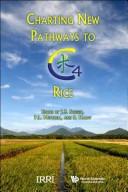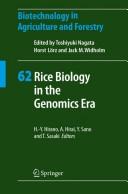| Listing 1 - 4 of 4 |
Sort by
|

ISBN: 1281918830 9786611918835 9812709525 9789812709523 9789812709516 9812709517 Year: 2008 Publisher: New Jersey World Scientific
Abstract | Keywords | Export | Availability | Bookmark
 Loading...
Loading...Choose an application
- Reference Manager
- EndNote
- RefWorks (Direct export to RefWorks)
Feeding Asia in the 21st century will require a second Green Revolution. However, unlike in the first generation, future yield increases will have to be grown using less water and nitrogen in a world of unfavorable climate change - this can only be done by increasing the efficiency of the photosynthetic system, i.e. developing a C4 rice plant. If and when achieved, it would be the first nonevolutionary example of reconstructing the primary metabolism of a plant. The impact of such a scientific achievement would be undeniable, but it requires either a superb feat of genetic engineering or forc
Rice --- Crop yields. --- Photosynthesis. --- Photobiology --- Plants --- Gases from plants --- Crops --- Field crops --- Yields, Crop --- Agricultural productivity --- Soil productivity --- Lowland paddy --- Lowland rice --- Oryza sativa --- Paddy (Plant) --- Padi --- Palay --- Oryza --- Genetic engineering. --- Yields. --- Effect of light on --- Photorespiration --- Yields
Periodical
Abstract | Keywords | Export | Availability | Bookmark
 Loading...
Loading...Choose an application
- Reference Manager
- EndNote
- RefWorks (Direct export to RefWorks)
Rice --- Riz --- Genetics --- Periodcals --- Physiology --- Periodicals --- Génétique --- Périodiques --- Physiologie --- Oryza --- genetics. --- physiology. --- Genetics. --- Physiology. --- Oryza sativa --- Plant Sciences --- Plant Genetics & Genomics --- Plant Breeding/Biotechnology --- Agriculture --- Plant Ecology --- Rices --- Lowland paddy --- Lowland rice --- Paddy (Plant) --- Padi --- Palay --- rice genetics --- rice genomics --- comparative biology --- plant sciences --- Plant husbandry
Book
ISBN: 9780253352194 0253352193 9786612238291 1282238299 0253002966 9780253002969 9781282238299 6612238291 Year: 2008 Publisher: Bloomington Indiana University Press
Abstract | Keywords | Export | Availability | Bookmark
 Loading...
Loading...Choose an application
- Reference Manager
- EndNote
- RefWorks (Direct export to RefWorks)
Mangrove rice farming on West Africa's Rice Coast was the mirror image of tidewater rice plantations worked by enslaved Africans in 18th-century South Carolina and Georgia. This book reconstructs the development of rice-growing technology among the Baga and Nalu of coastal Guinea, beginning more than a millennium before the transatlantic slave trade. It reveals a picture of dynamic pre-colonial coastal societies, quite unlike the static, homogenous pre-modern Africa of previous scholarship. From its examination of inheritance, innovation, and borrowing, Deep Roots fashions a theory of cultural change that encompasses the diversity of communities, cultures, and forms of expression in Africa and the African diaspora.
Baga (African people) --- Nalu (African people) --- Rice farmers --- Rice trade --- Rice --- Slave trade --- Slavery --- Agriculture --- History --- SOCIAL SCIENCE --- Anthropology / Cultural --- History & Archaeology --- Regions & Countries - Africa --- Abolition of slavery --- Antislavery --- Enslavement --- Mui tsai --- Ownership of slaves --- Servitude --- Slave keeping --- Slave system --- Slaveholding --- Thralldom --- Lowland paddy --- Lowland rice --- Oryza sativa --- Paddy (Plant) --- Padi --- Palay --- Rice industry --- Crimes against humanity --- Serfdom --- Slaveholders --- Slaves --- Oryza --- Grain trade --- Farmers --- Rice workers --- Enslaved persons

ISBN: 1281179132 9786611179137 3540742506 3540742484 3642093582 Year: 2008 Volume: v. 62 Publisher: Berlin : Springer,
Abstract | Keywords | Export | Availability | Bookmark
 Loading...
Loading...Choose an application
- Reference Manager
- EndNote
- RefWorks (Direct export to RefWorks)
Rice (Oryza sativa) is one of the most important staple food crops in the world. Breeding efforts to improve the agronomical quality of rice have been conducted, and studies on rice from the viewpoint of basic biological interest have also been carried out. In 1991, a book entitled Rice (edited by Dr. Bajaj) was published as the 14th volume in the series Biotechnology in Agriculture and Forestry (BAF), detailing rice research activities at that time, and focusing mainly on cell and tissue culture and genetic variability. Studies on rice have fundamentally advanced since then, whose outcomes are mentioned below. This is a good reason to compile a new volume on rice. The situation regarding rice research has markedly changed in the last 16 years. First, the genomic sequences of rice were completely determined by the International Rice Genome Sequencing Project in 2004. Since the genome sequence of Arabidopsis thaliana had been determined in 2000, rice became the second species in the seed plants to have its genome well understood. Second, the technology to transform rice by the Agrobacterium-mediated method was developed and is now established. In classical phytopathology, Poaceae (including rice) has not been considered as a host for Agrobacterium. This transformation method is relatively easy and reproducible as compared to conventional transformation methods using protoplasts, and is now widely used in rice research.
Rice --- Crop improvement. --- Molecular genetics. --- Biotechnology. --- Crops --- Improvement, Crop --- Agriculture --- Lowland paddy --- Lowland rice --- Oryza sativa --- Paddy (Plant) --- Padi --- Palay --- Oryza --- Improvement --- Agriculture. --- Plant genetics. --- Plant breeding. --- Plant anatomy. --- Plant Ecology. --- Evolution (Biology). --- Plant Genetics and Genomics. --- Plant Breeding/Biotechnology. --- Plant Anatomy/Development. --- Evolutionary Biology. --- Botany --- Plants --- Ecology --- Plant structure --- Structural botany --- Vegetable anatomy --- Anatomy --- Breeding --- Animal evolution --- Animals --- Biological evolution --- Darwinism --- Evolutionary biology --- Evolutionary science --- Origin of species --- Biology --- Evolution --- Biological fitness --- Homoplasy --- Natural selection --- Phylogeny --- Genetics --- Farming --- Husbandry --- Industrial arts --- Life sciences --- Food supply --- Land use, Rural --- Structure --- Phytoecology --- Vegetation ecology --- Plant development. --- Plant ecology. --- Evolutionary biology. --- Development of plants --- Plant development --- Developmental biology --- Growth (Plants) --- Ontogeny --- Floristic ecology --- Plant biotechnology. --- Plants—Development. --- Plant Genetics. --- Plant Biotechnology. --- Plant Development. --- Crop biotechnology --- Agricultural biotechnology --- Biotechnology
| Listing 1 - 4 of 4 |
Sort by
|

 Search
Search Feedback
Feedback About UniCat
About UniCat  Help
Help News
News